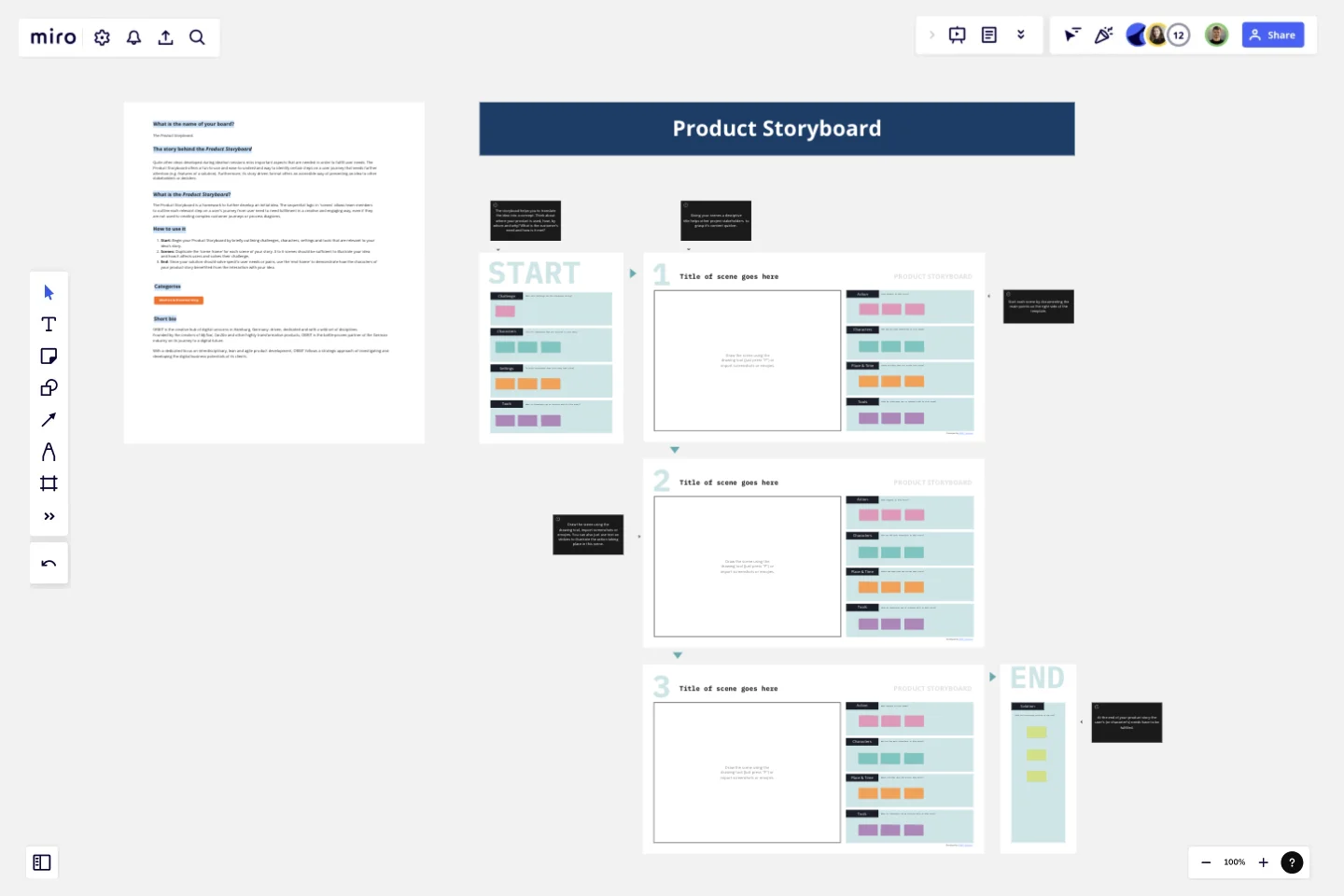The Product Storyboard
Quite often ideas developed during ideation sessions miss important aspects that are needed in order to fulfill user needs.
The story behind the Product Storyboard
The Product Storyboard offers a fun-to-use and ease-to-understand way to identify certain steps on a user journey that needs further attention (e.g. features of a solution). Furthermore, it's story-driven format offers an accessible way of presenting an idea to other stakeholders or deciders.
What is the Product Storyboard?
The Product Storyboard is a framework to further develop an initial idea. The sequential logic in 'scenes' allows team members to outline each relevant step on a user's journey from user need to need fulfilment in a creative and engaging way, even if they are not used to creating complex customer journeys or process diagrams.
How to use it
Start: Begin your Product Storyboard by briefly outlining challenges, characters, settings and tools that are relevant to your idea's story.
Scenes: Duplicate the 'scene frame' for each scene of your story. 3 to 6 scenes should be sufficient to illustrate your idea and how it affects users and solves their challenge.
End: Since your solution should solve specific user needs or pains, use the 'end frame' to demonstrate how the characters of your product story benefitted from the interaction with your idea.
This template was created by Nono Weinzierl. Discover more storyboard template examples and map your next project.
Get started with this template right now.
Customer Touchpoint Map Template
Works best for:
Desk Research, Product Management, Mapping
To attract and keep loyal customers, you have to truly start to understand them—their pain point, wants, and needs. A customer touchpoint map helps you gain that understanding by visualizing the path your customers follow, from signing up for a service, to using your site, to buying your product. And because no two customers are exactly alike, a CJM lets you plot out multiple pathways through your product. Soon you’ll be able to anticipate those pathways and satisfy your customers at every step.
Gap Analysis Template
Works best for:
Marketing, Strategic Planning, Business Management
Consider your team’s or organization’s ideal state. Now compare it to your current real-world situation. Want to identify the gaps or obstacles that stand between your present and future? Then you’re ready to run a gap analysis. This easy-to-customize template will let your team align on what obstacles are preventing you from hitting your goals sooner, collaborate on a plan to achieve those goals, and push your organization toward growth and development. You can focus on specific gap analyses — including for skills, candidates, software, processes, vendors, data, and more.
Product Thinking Board
Works best for:
Product Management, Planning
Product Thinking Board template encourages a user-centered approach to product development. By fostering empathy, collaboration, and experimentation, this template stimulates innovative thinking and problem-solving. With sections for user research, ideation, and prototyping, it supports iterative product design and validation. This template serves as a visual framework for product teams to engage in user-centric design thinking processes, driving the creation of products that truly meet user needs and deliver exceptional experiences.
Lean Inception Workshop
Works best for:
Agile, Lean Methodology
The Lean Inception Workshop streamlines project kickoff by aligning teams on goals, scope, and priorities. It leverages Lean principles to eliminate waste and maximize value, guiding exercises to define user personas, map user journeys, and prioritize features. By fostering cross-functional collaboration and customer-centric thinking, this template accelerates project initiation and ensures alignment between stakeholders, empowering teams to deliver customer value faster.
Backlog Refinement with Jira Template
Works best for:
Agile, Backlog Refinement
The Backlog Refinement with Jira template in Miro improves collaboration among team members. It provides a visual and interactive space for teams to review, prioritize, and clarify upcoming work items together in real time. This collaborative approach ensures alignment on priorities and details, leading to a more organized and efficient workflow. The seamless integration with Jira automatically syncs all changes, reducing the need for manual updates and keeping both platforms up-to-date.
Working Backwards Template
Works best for:
Desk Research, Strategic Planning, Product Management
Find out how to use the Working Backwards template to plan, structure, and execute the launch of a new product. Using the template, you’ll figure out if the product is worth launching in the first place.
